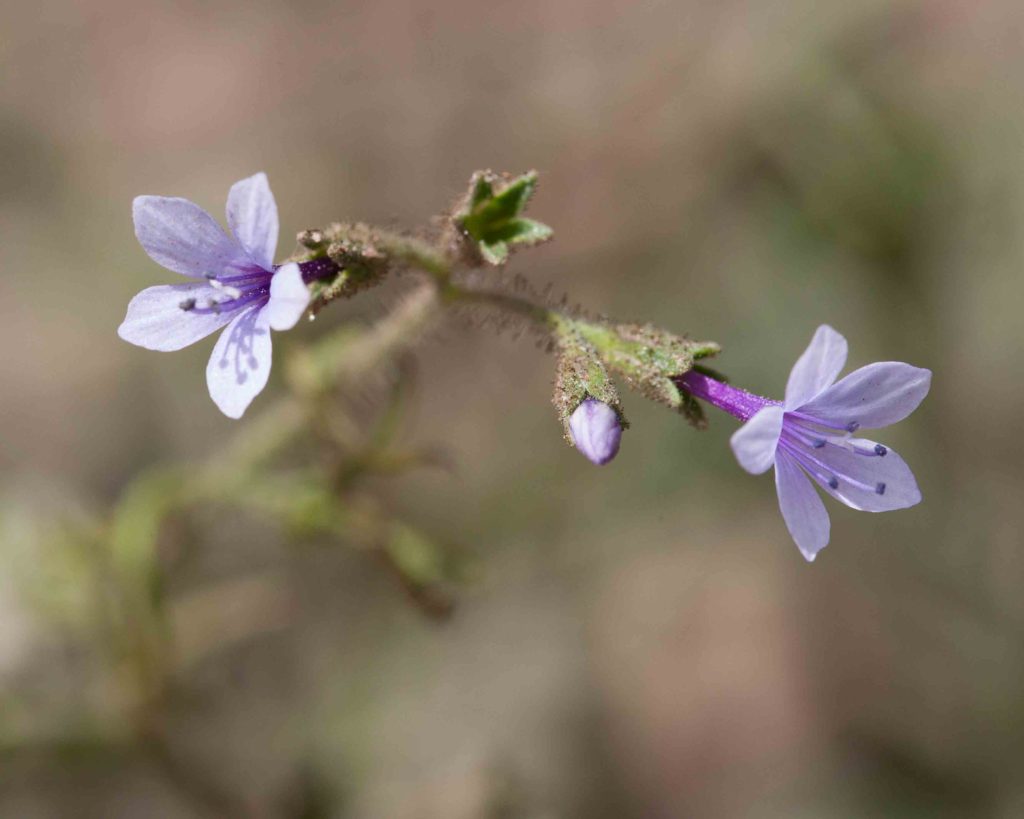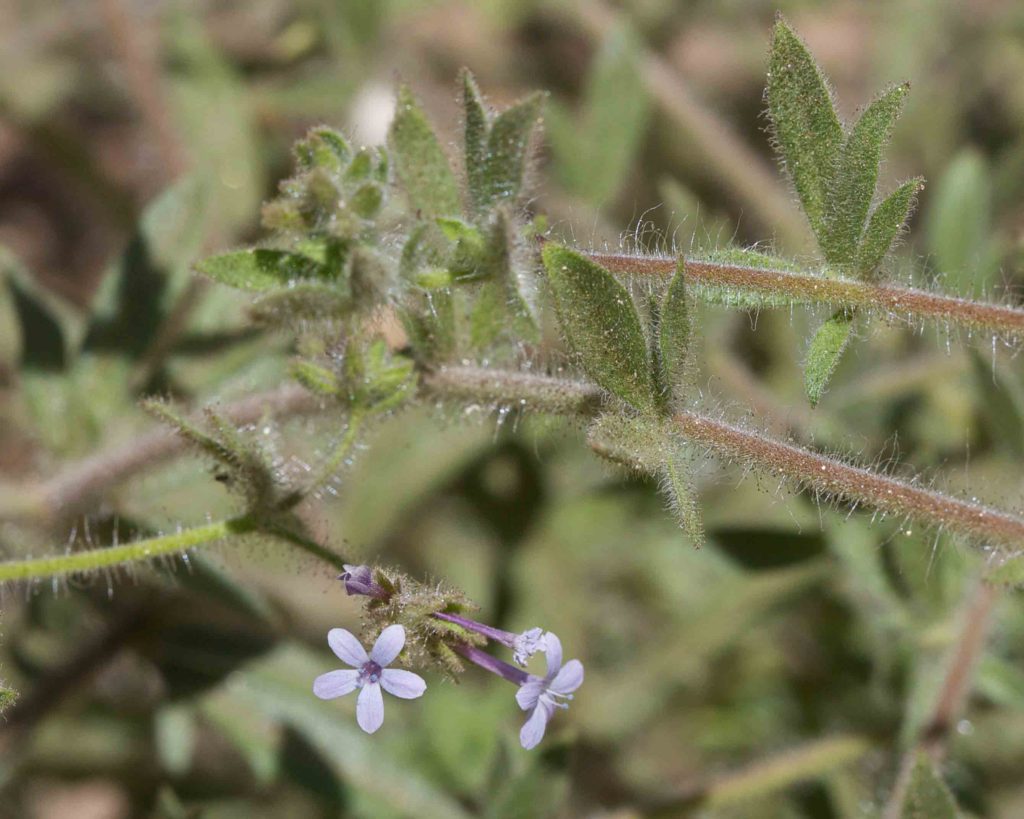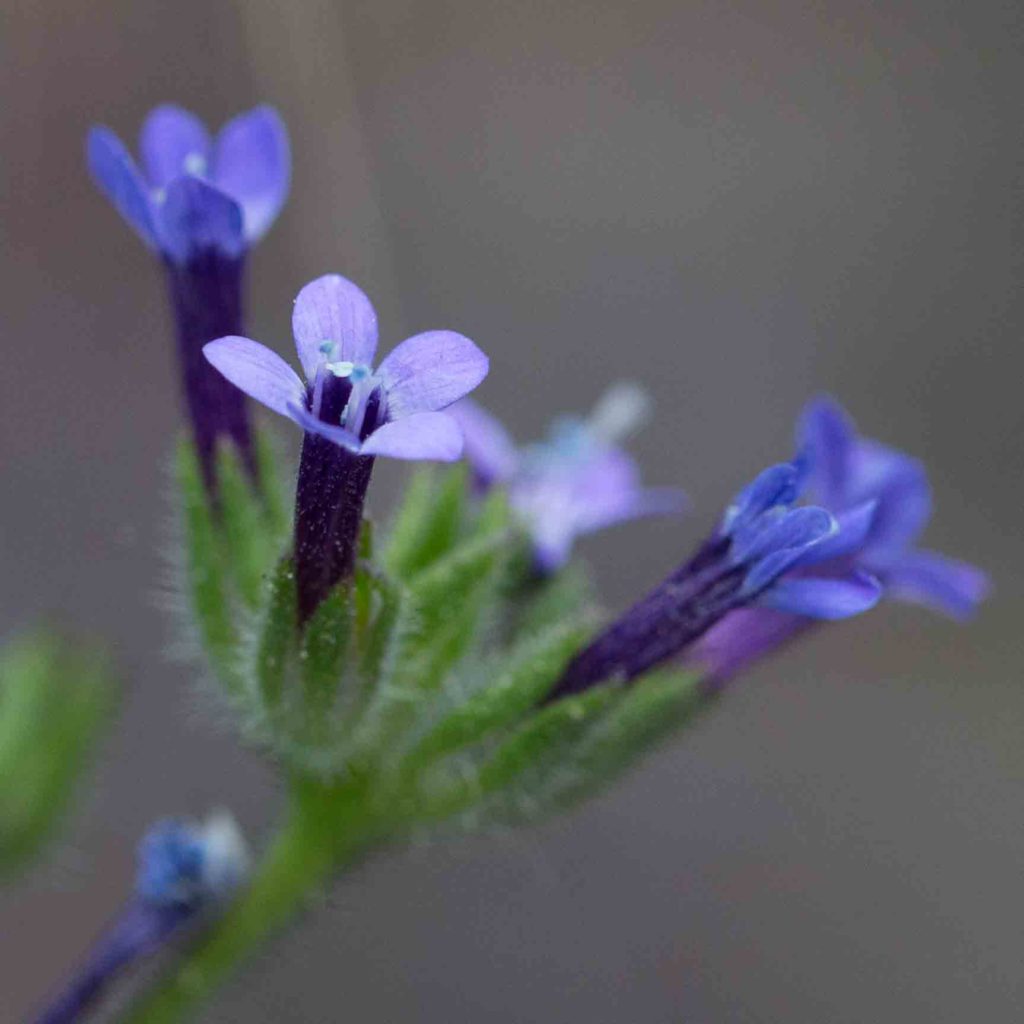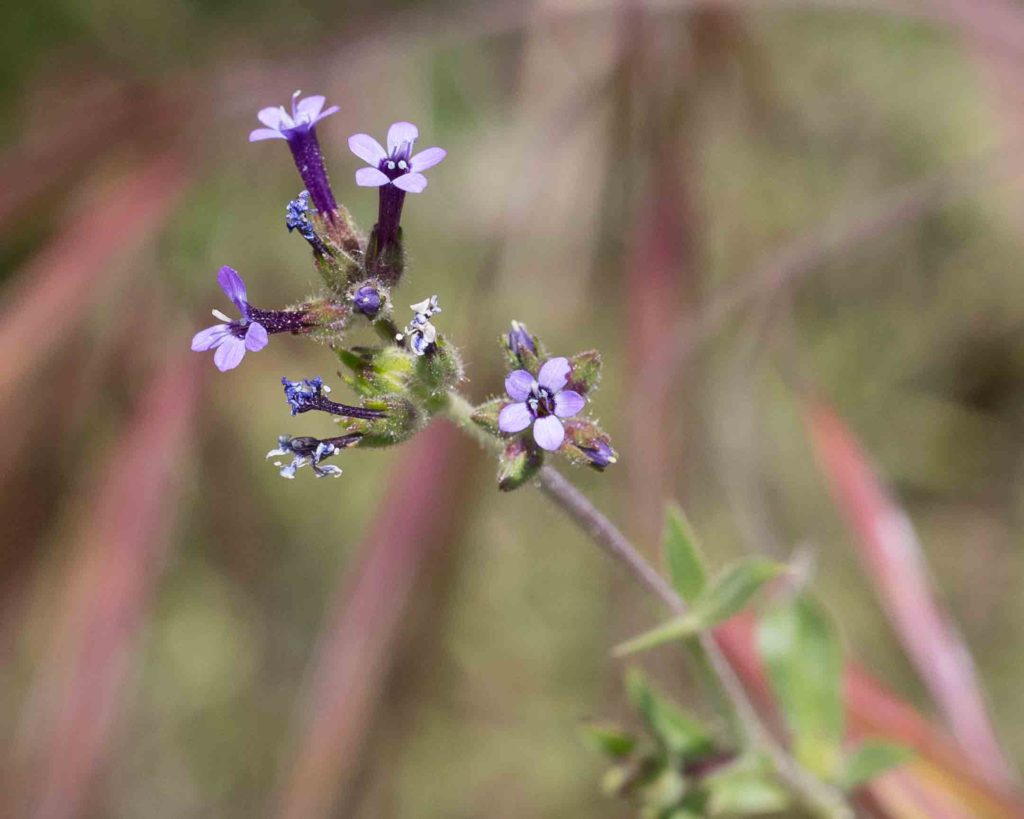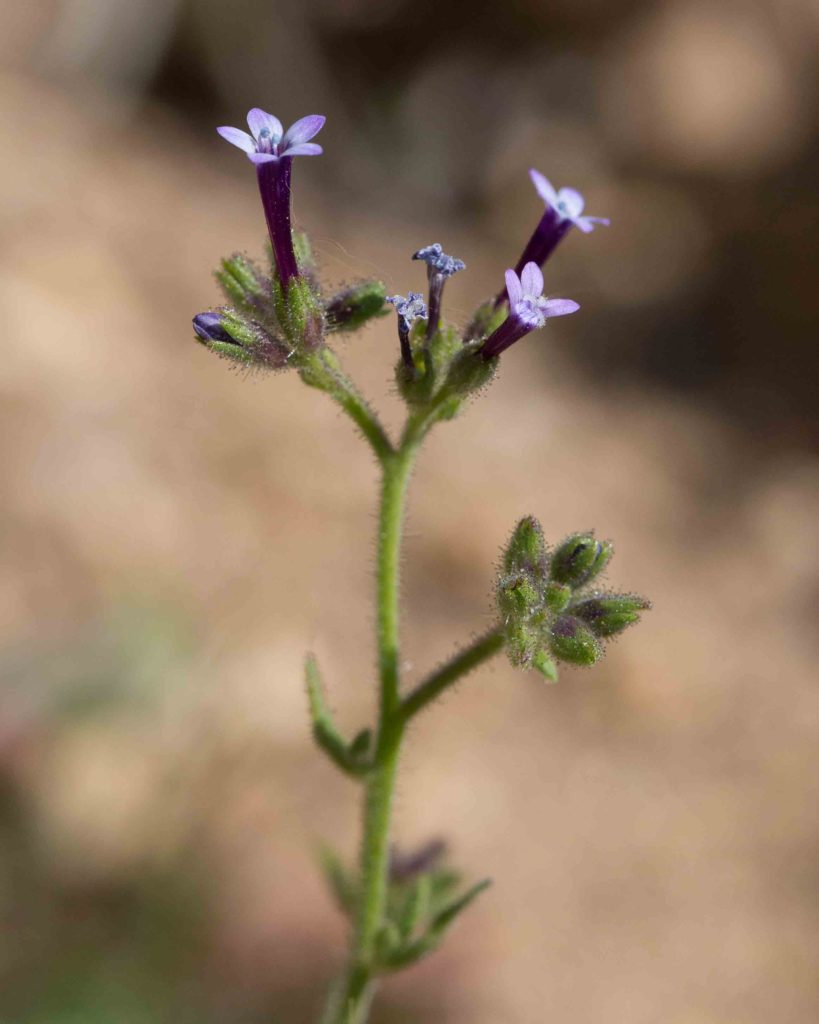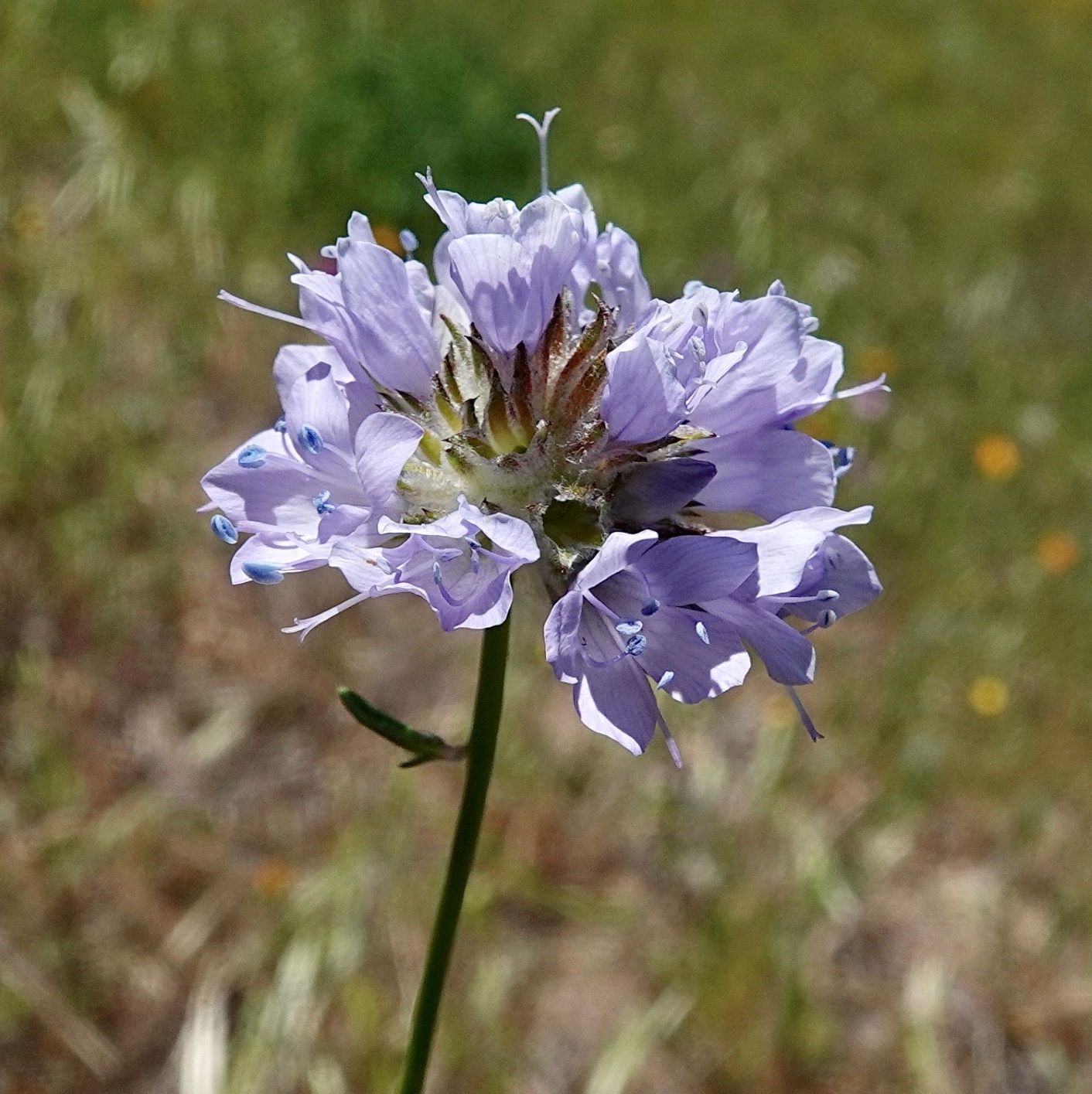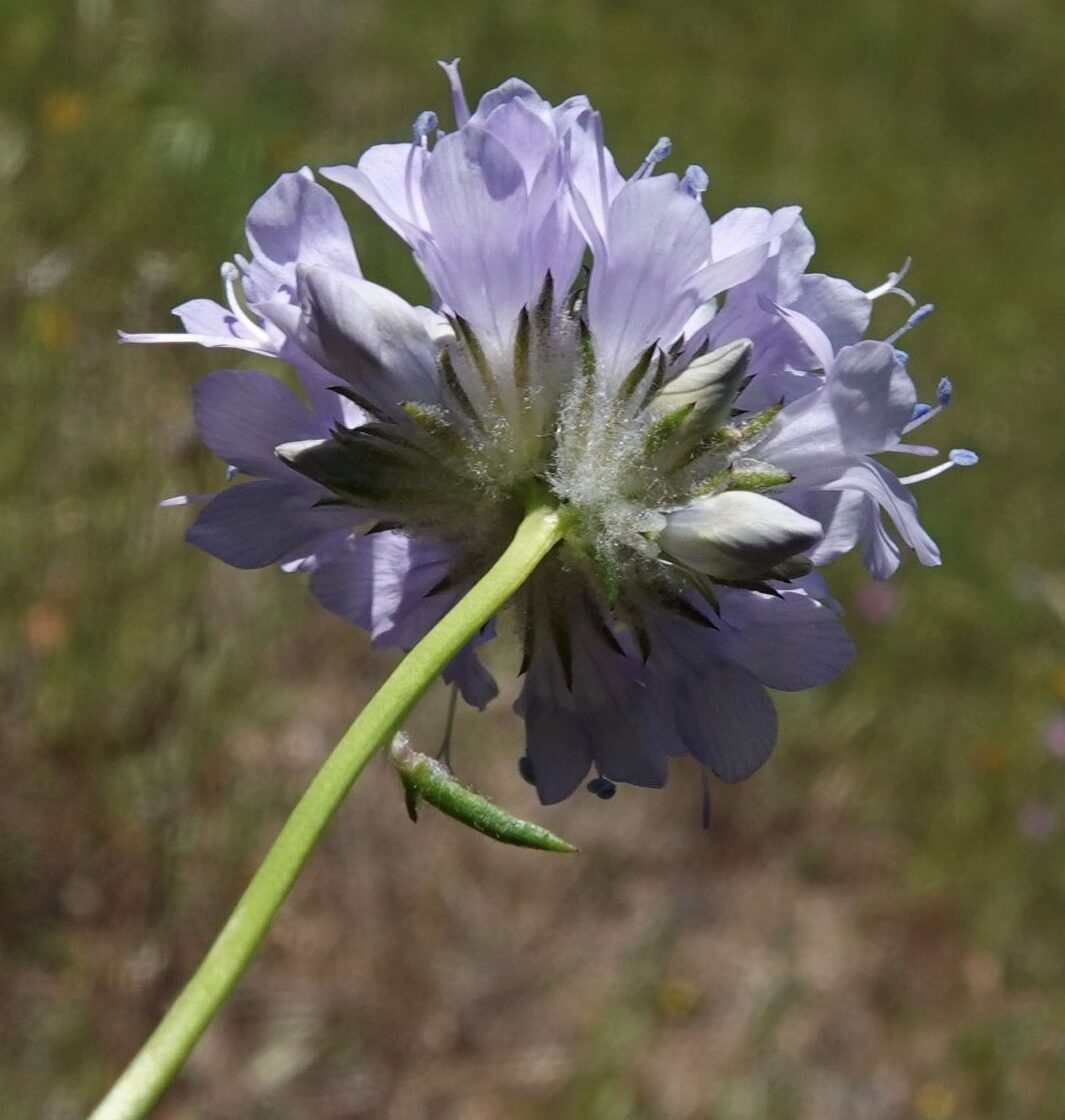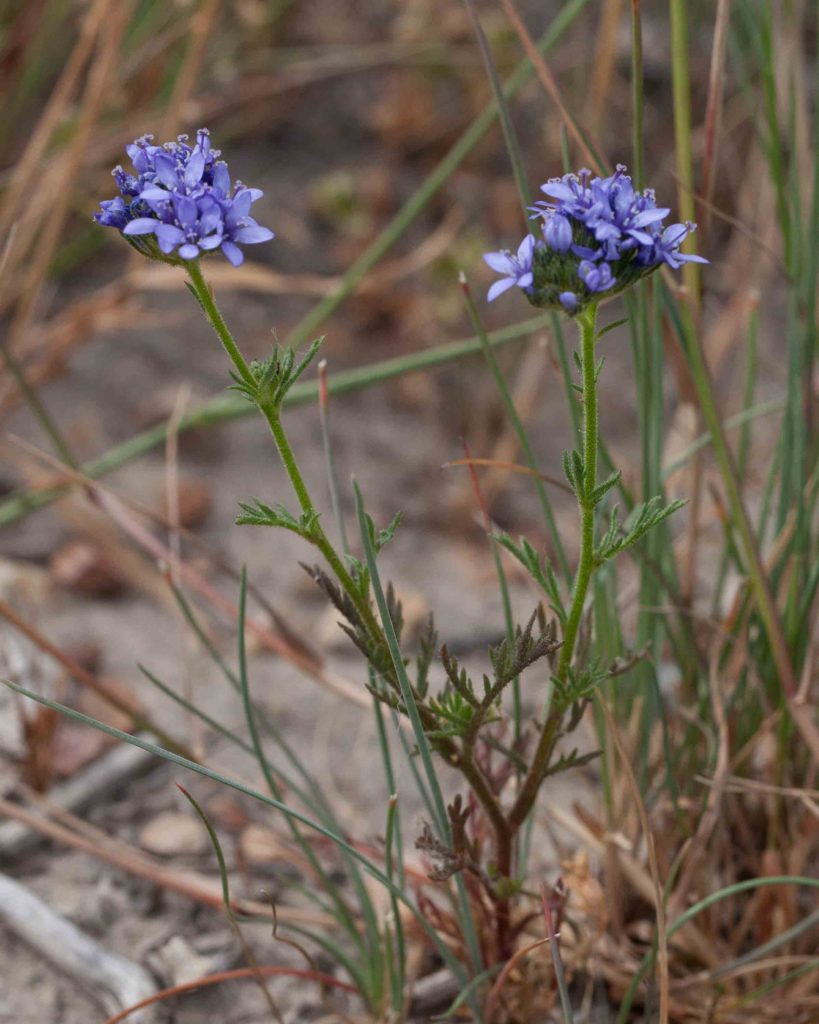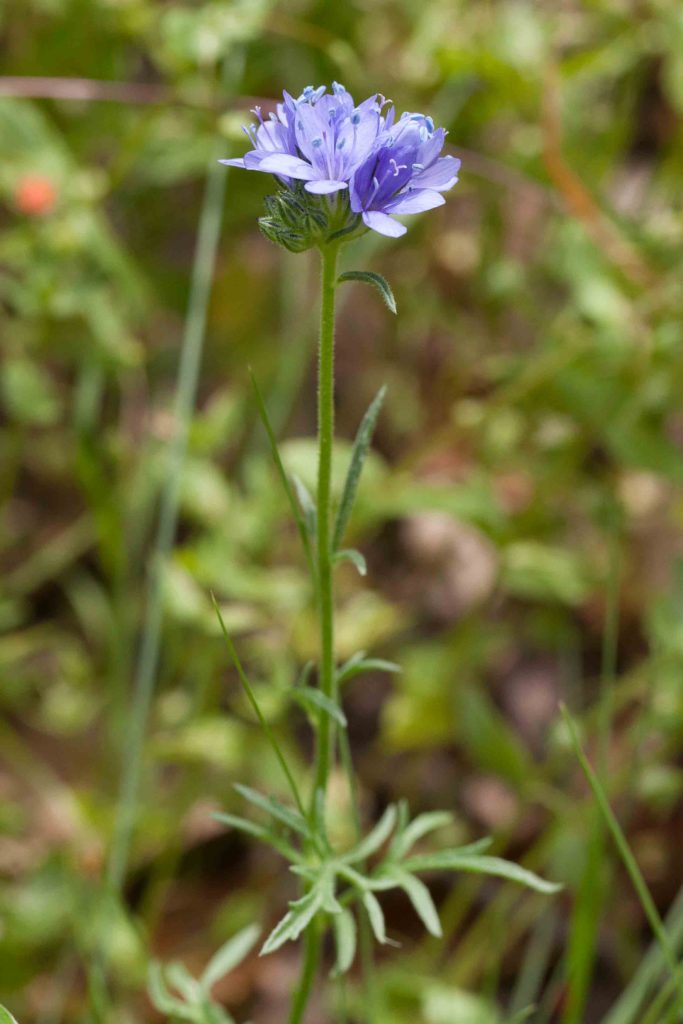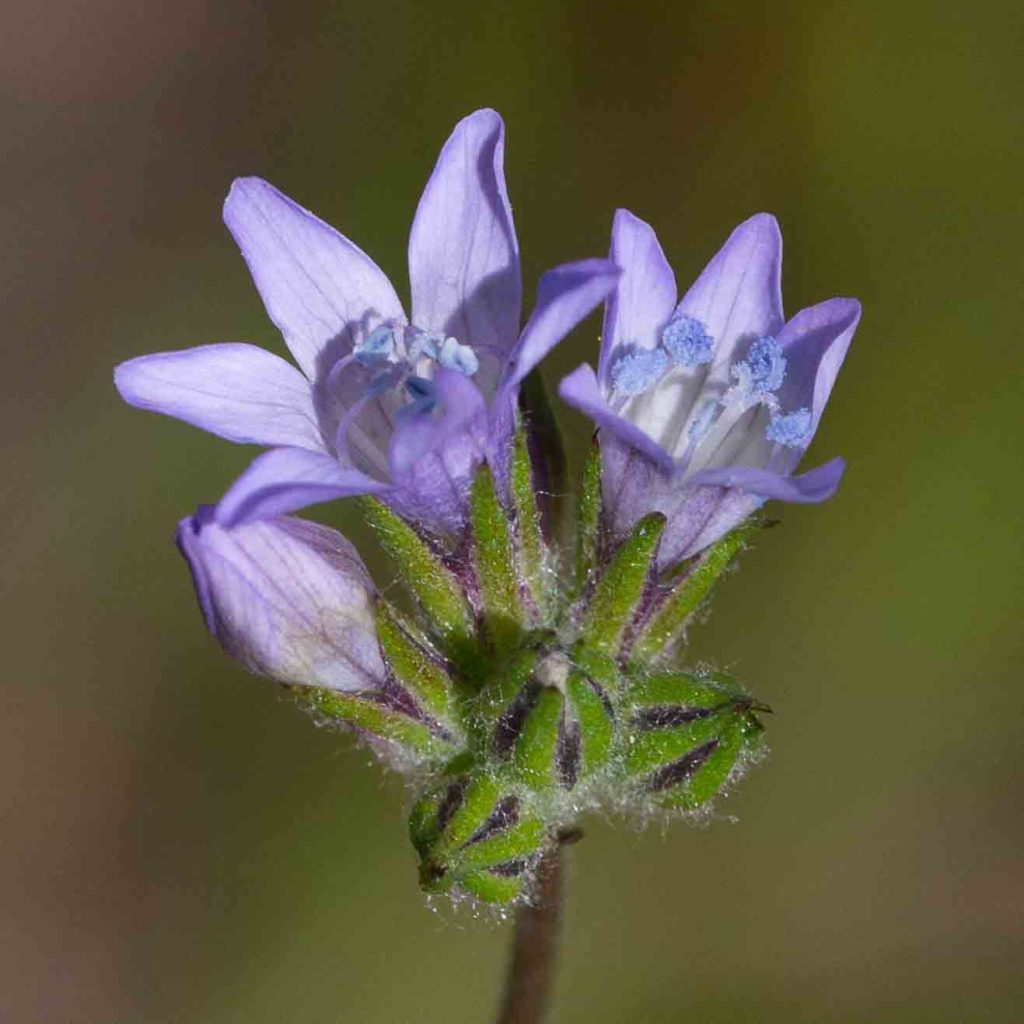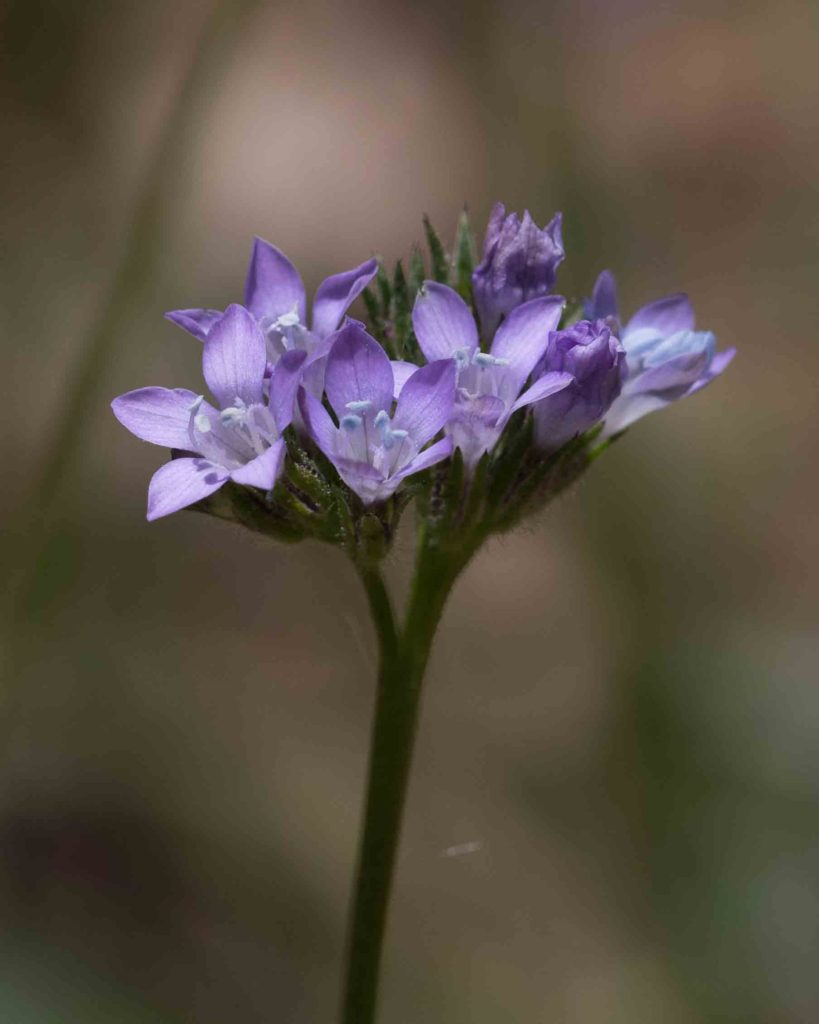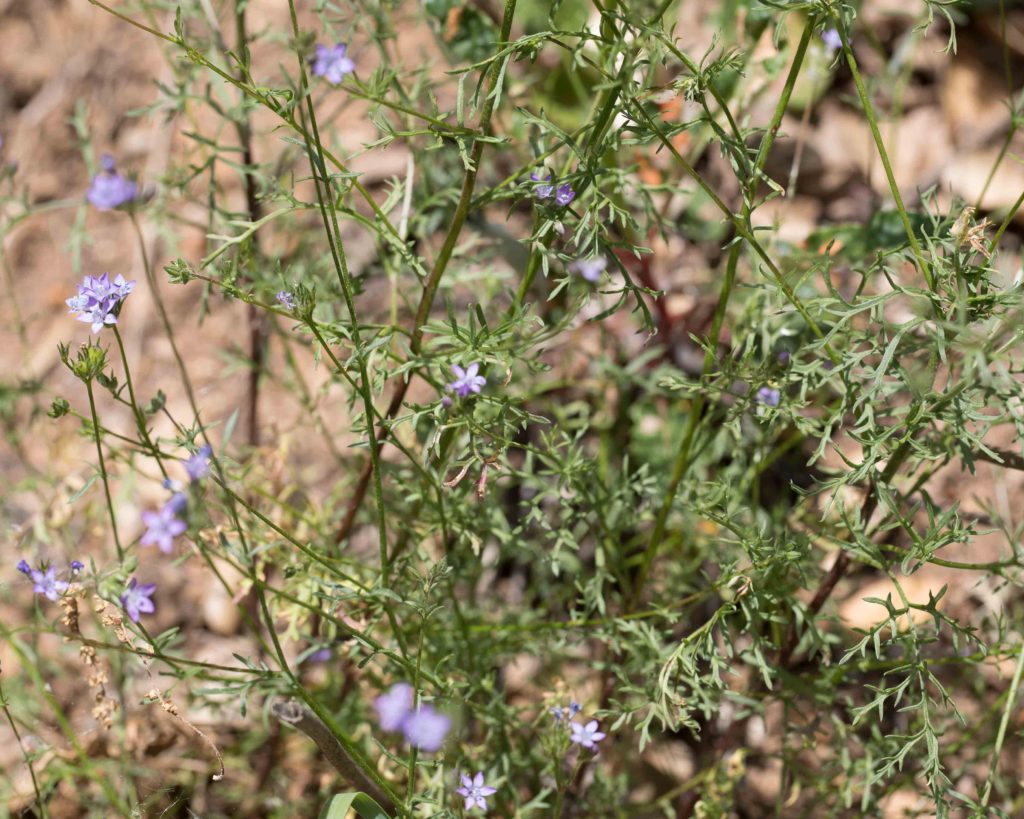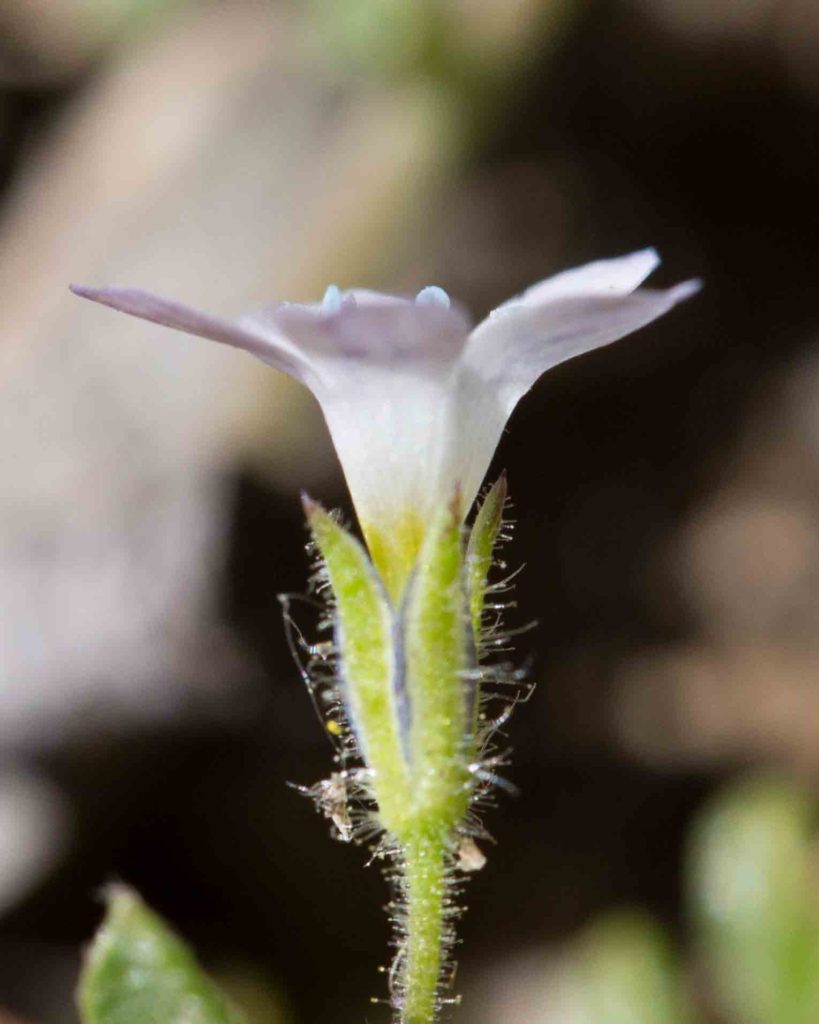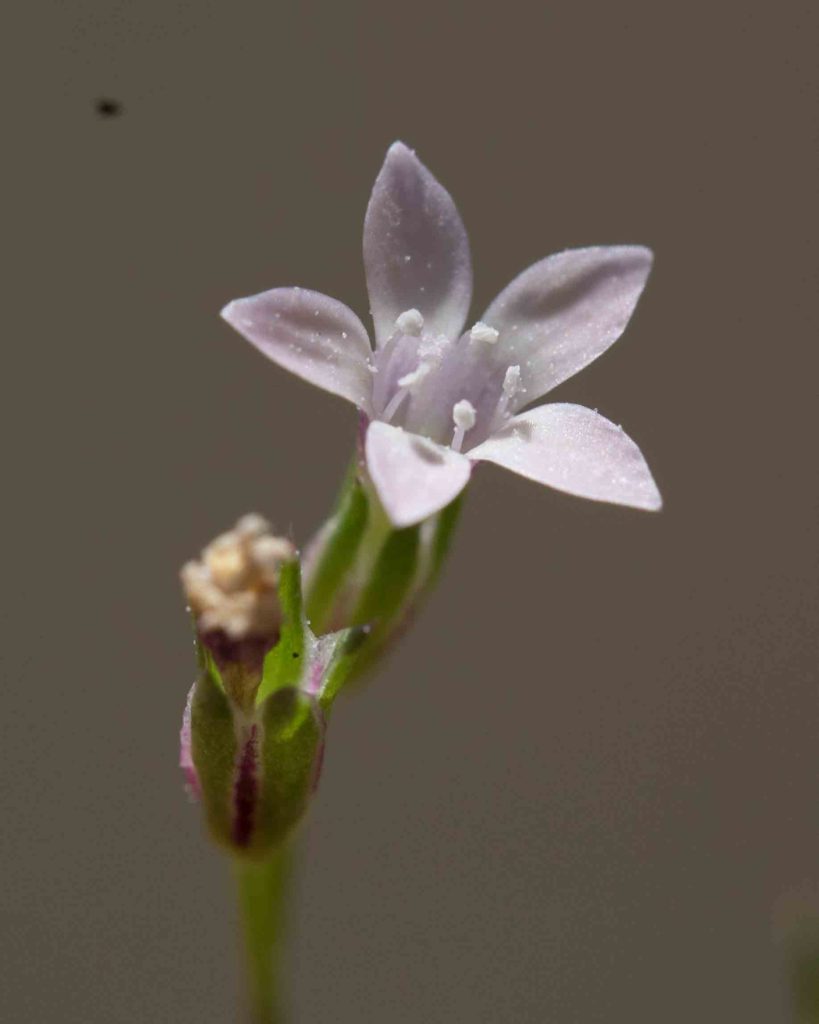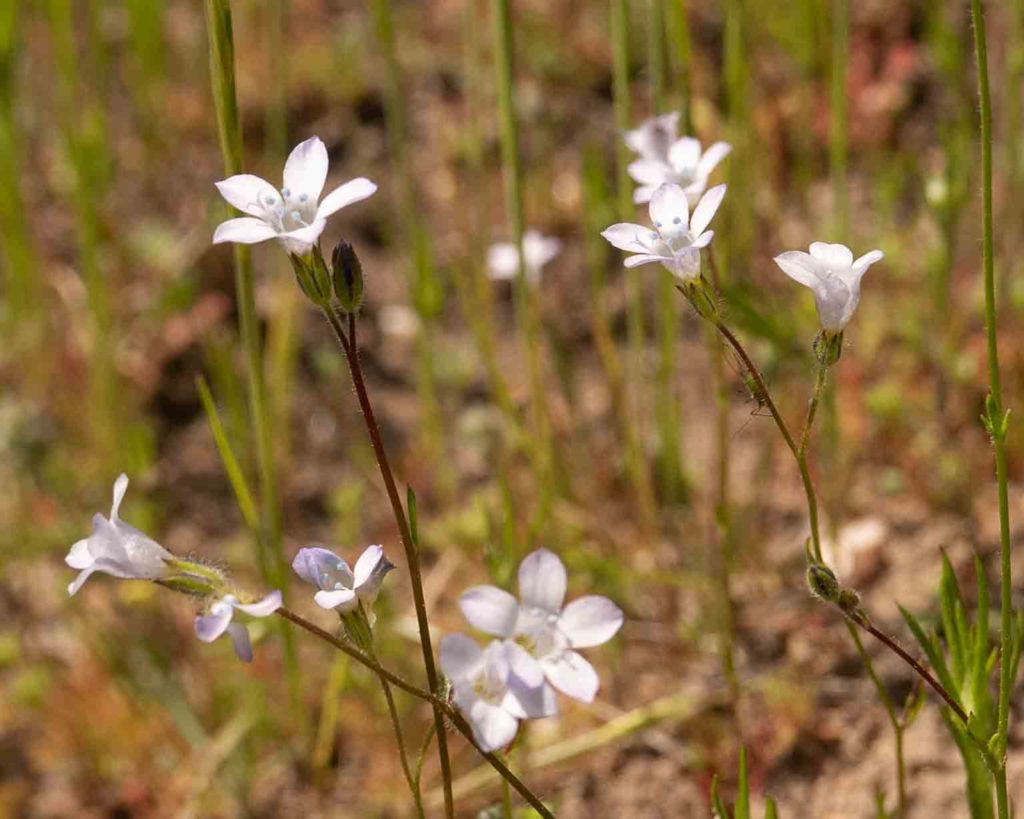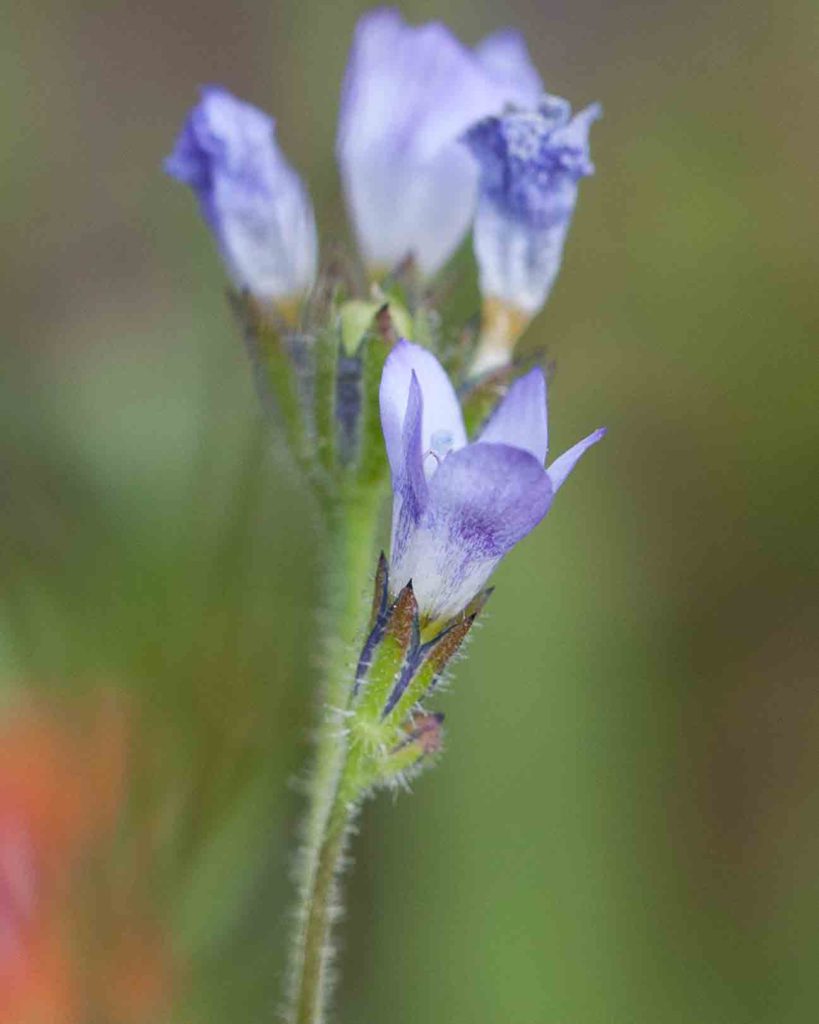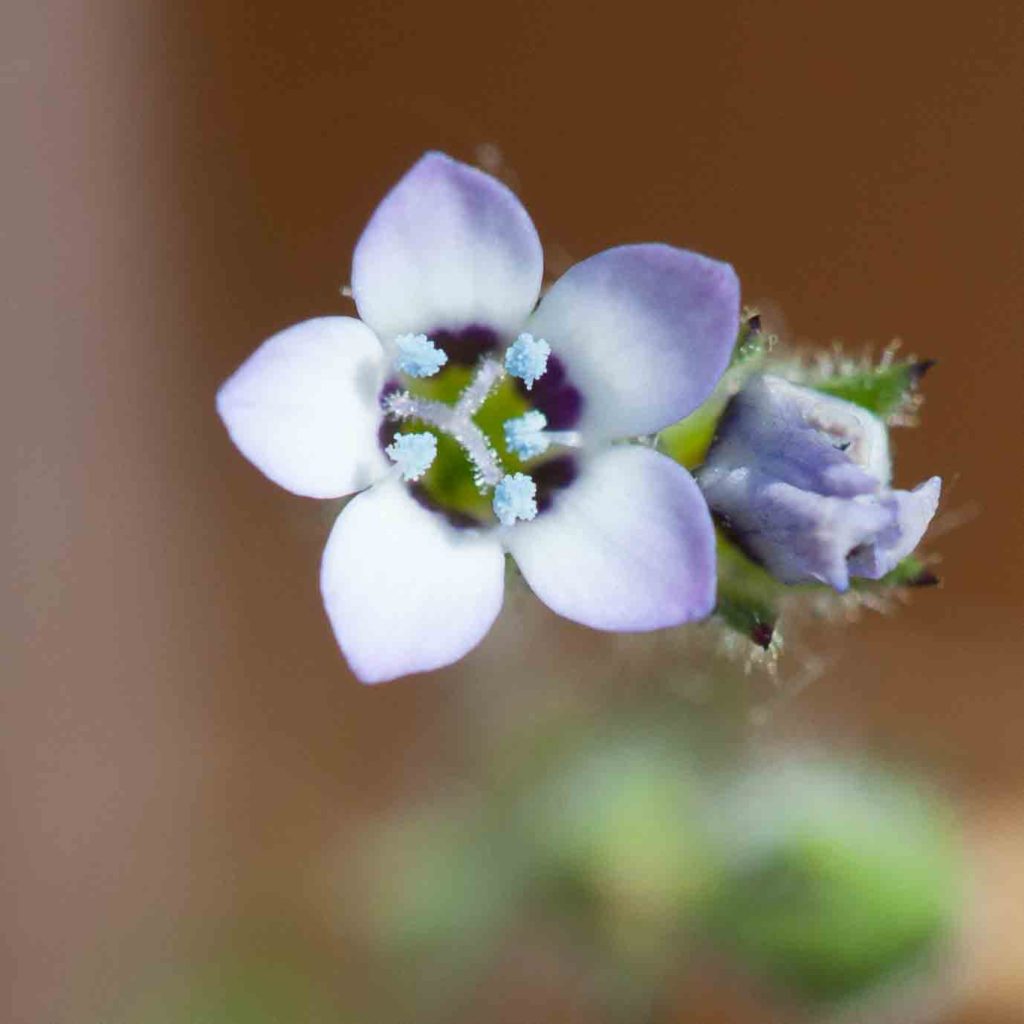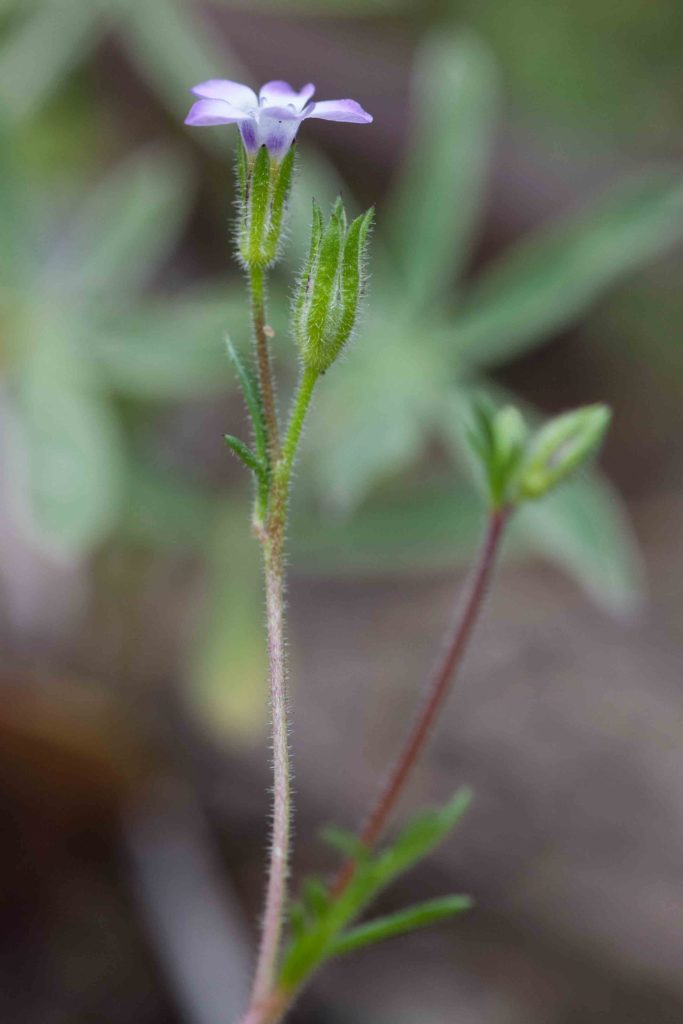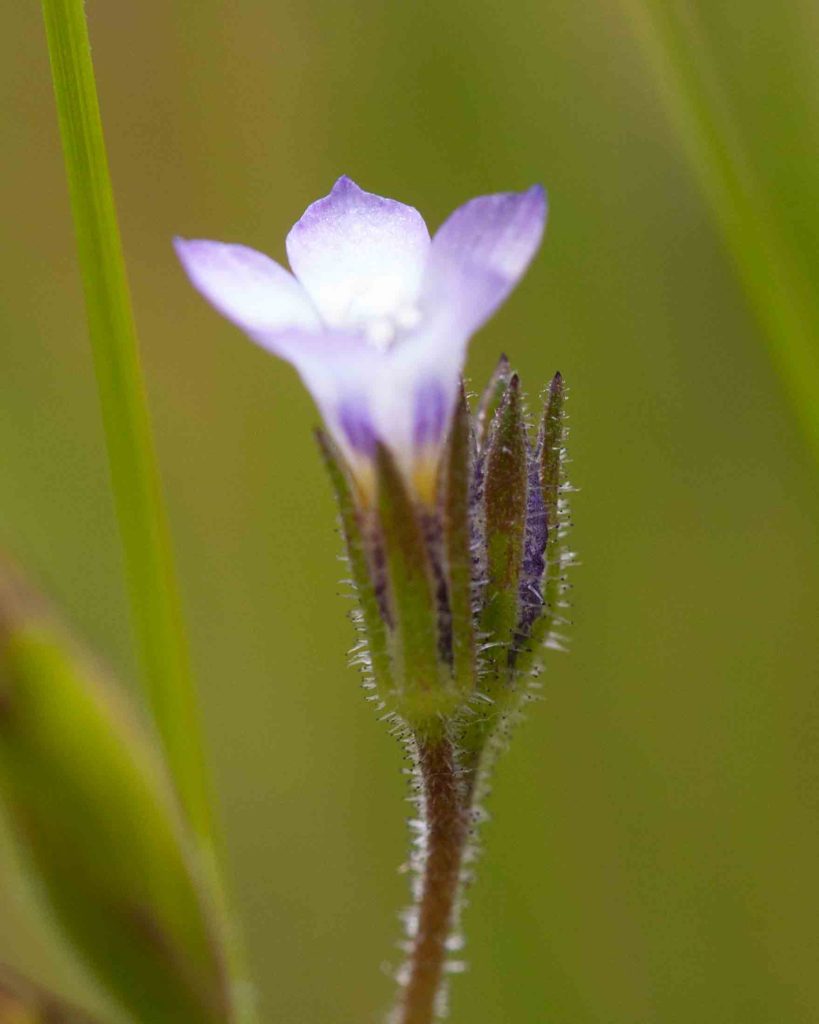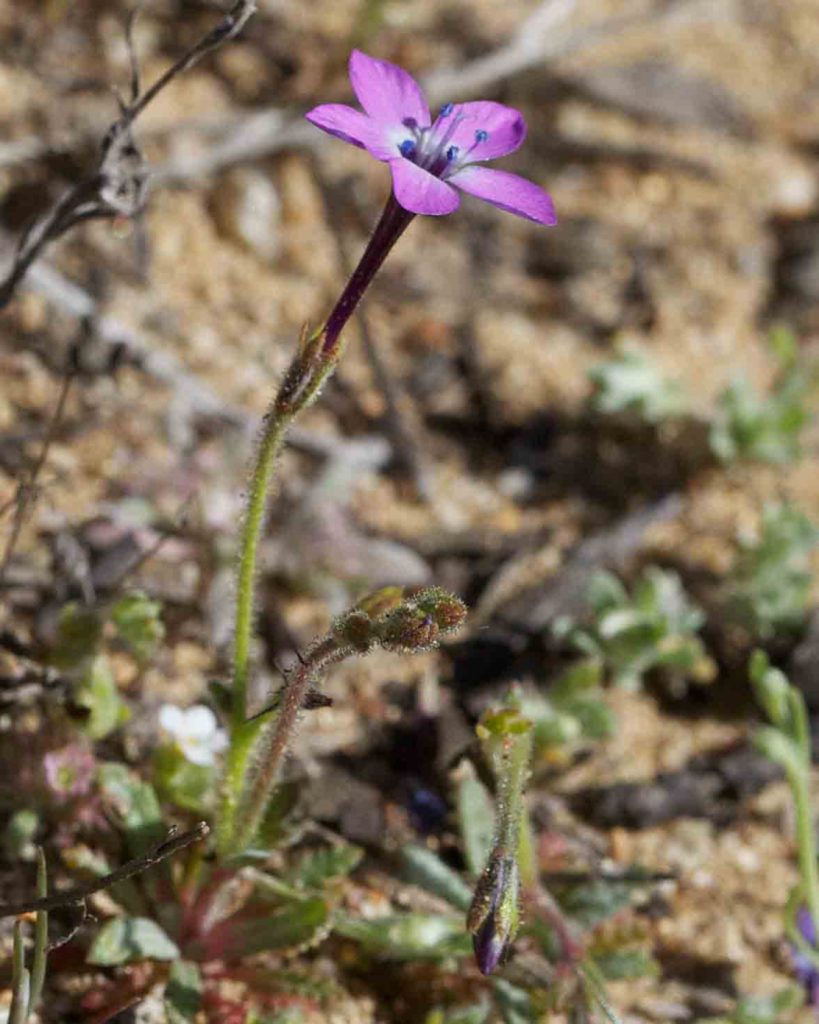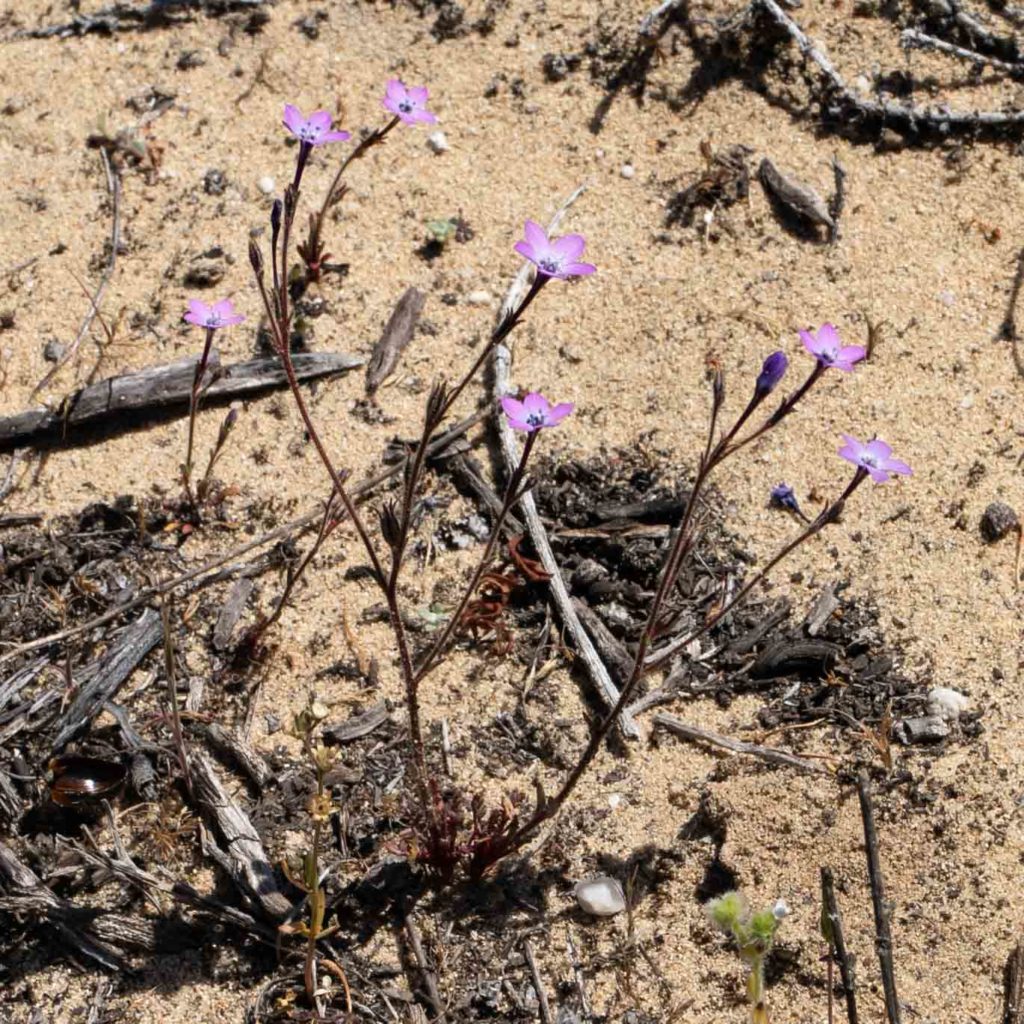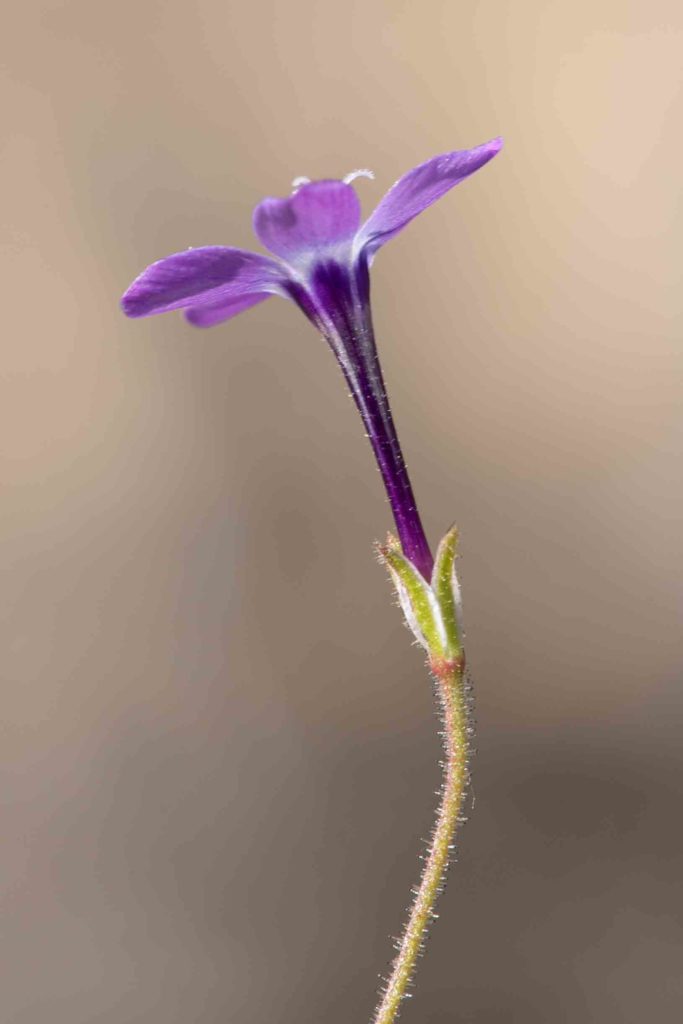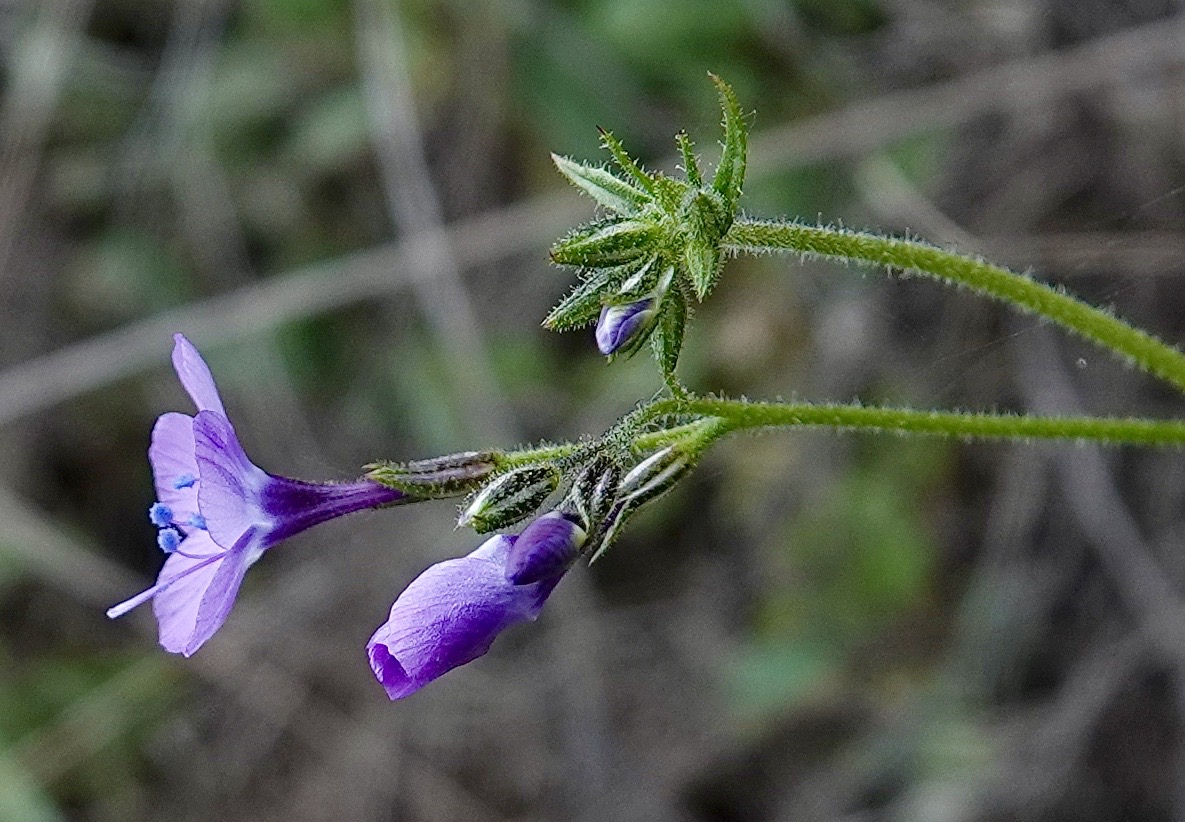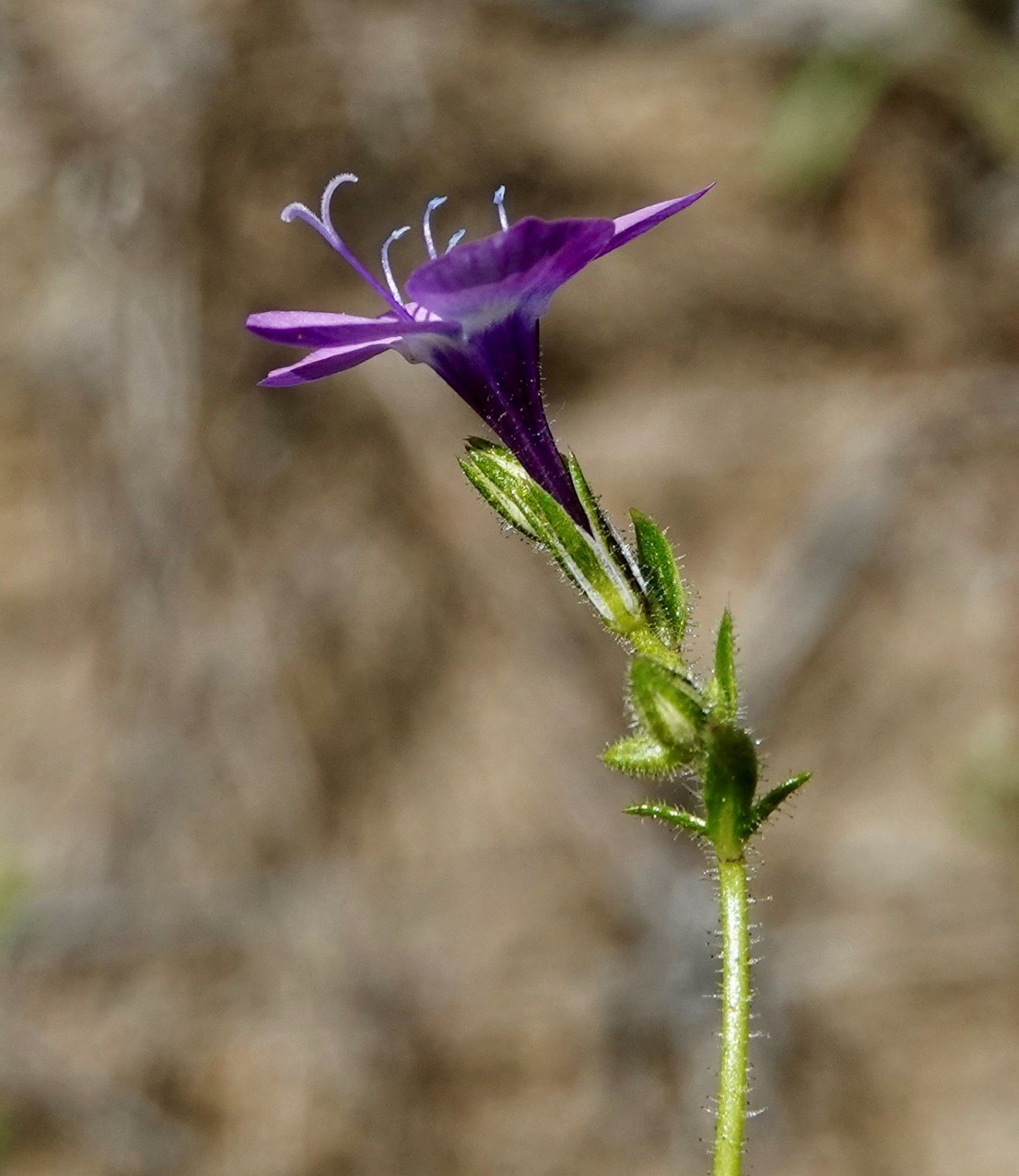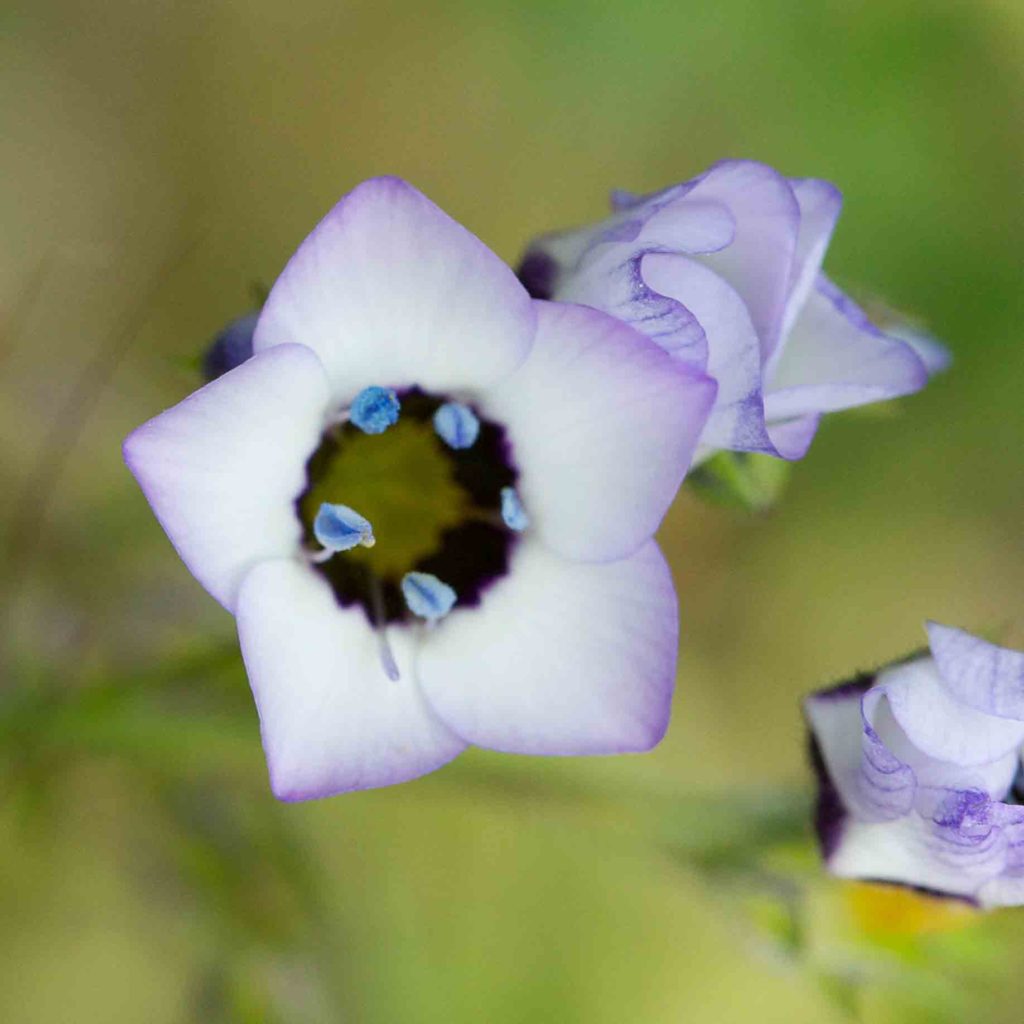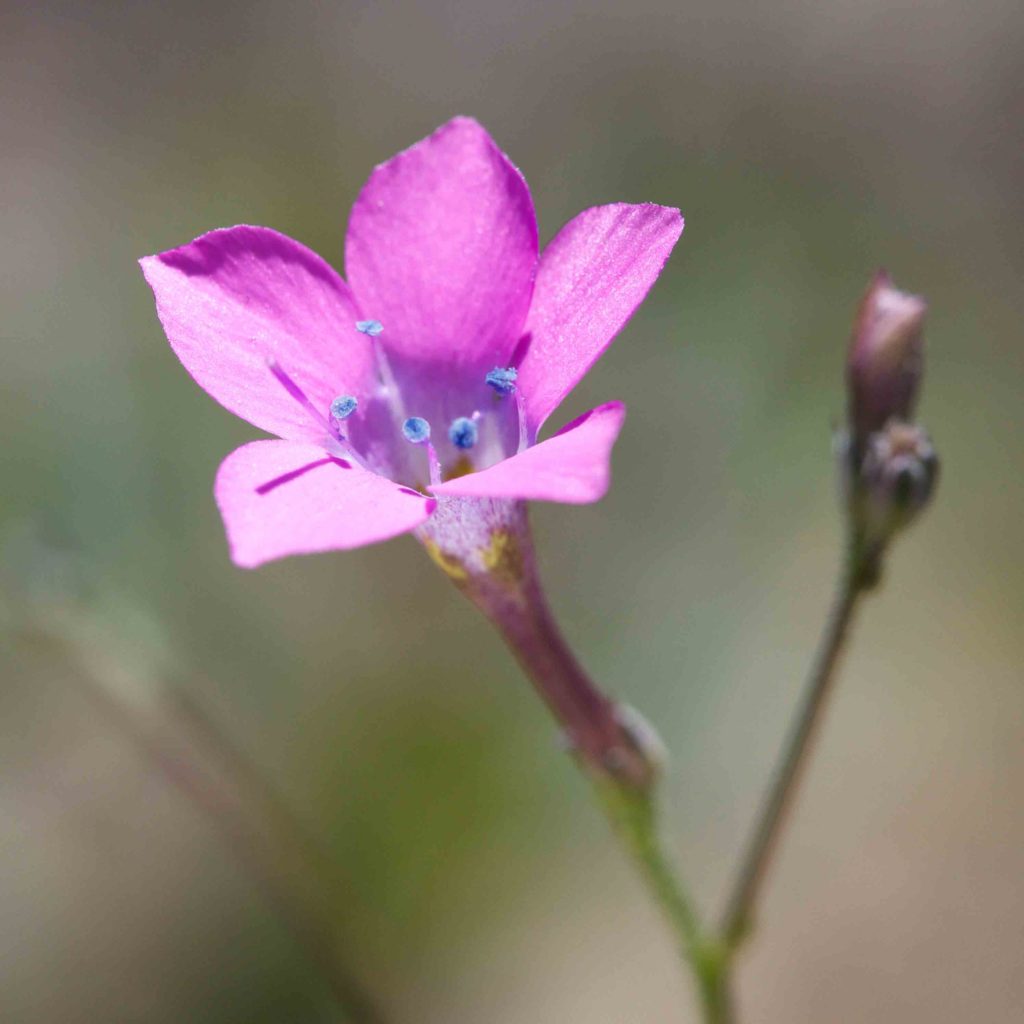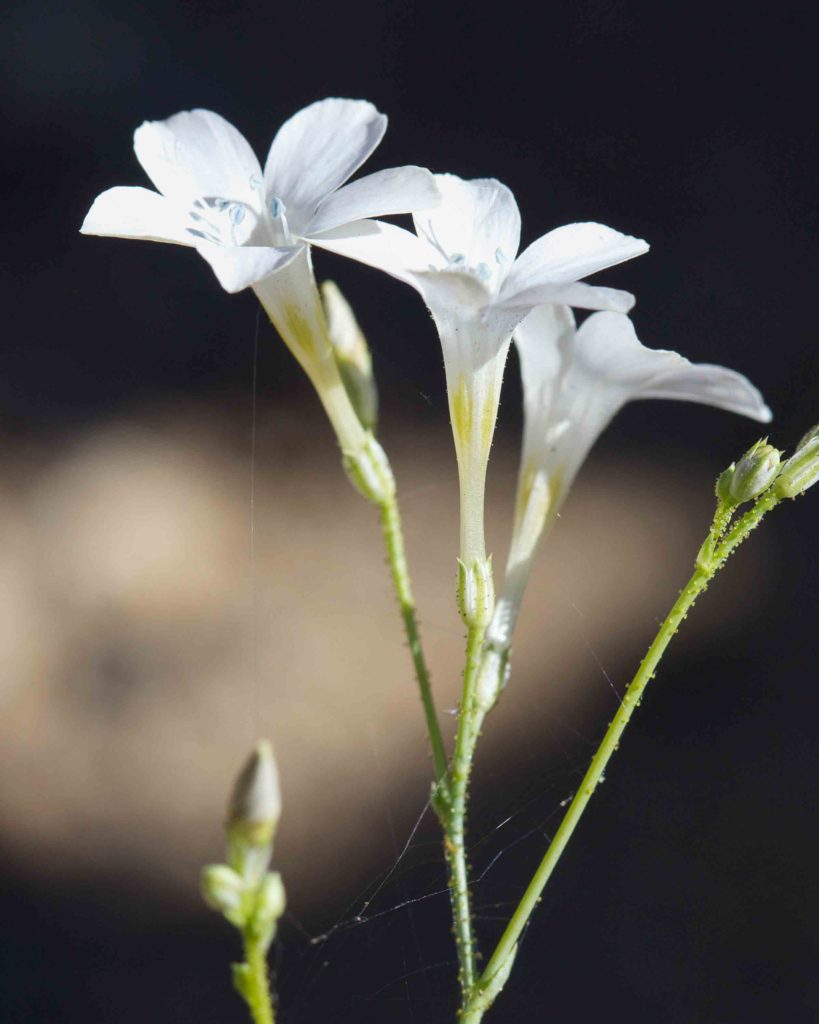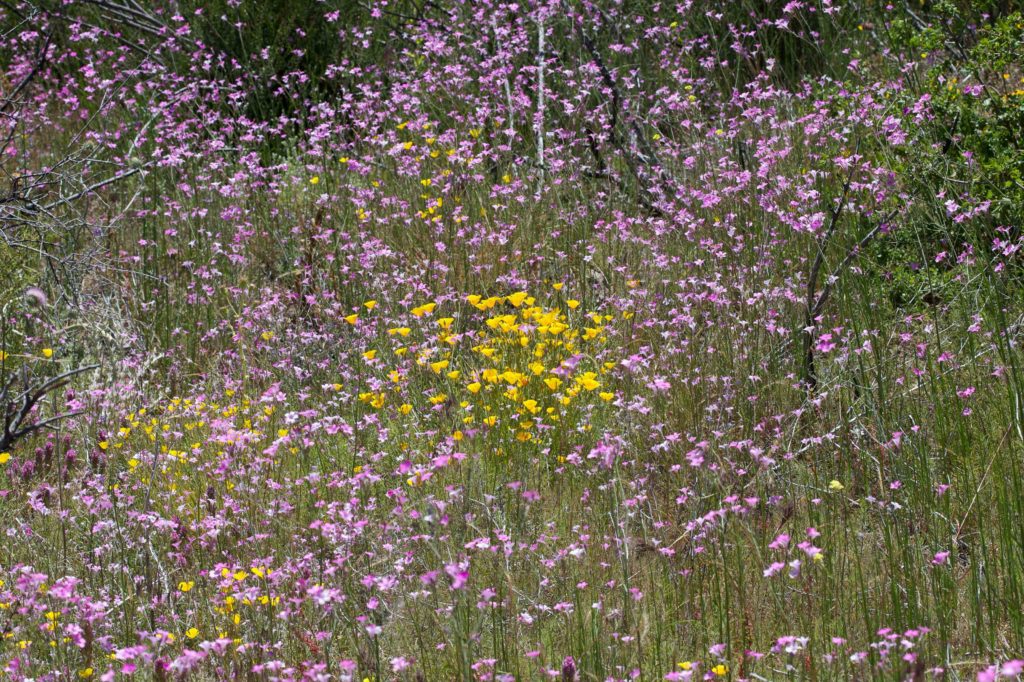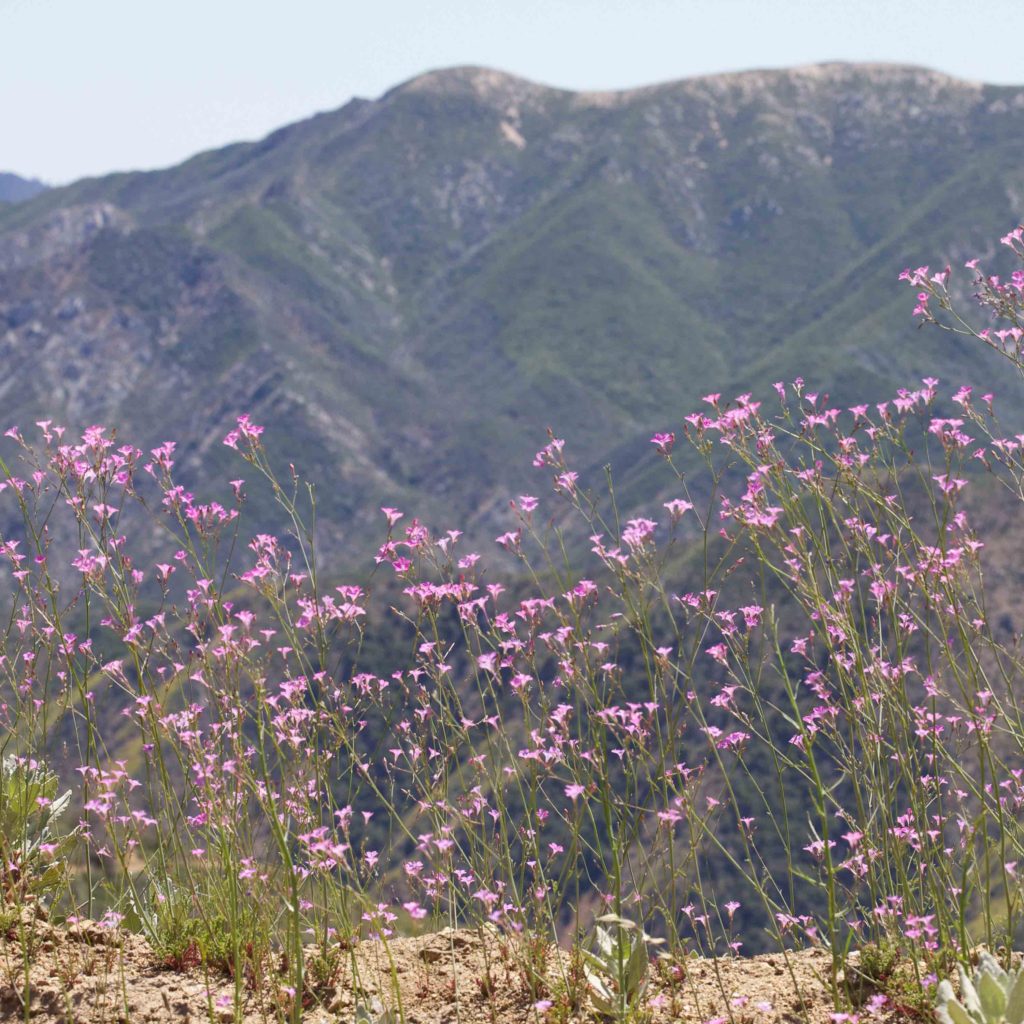Polemoniaceae: Phlox Family — Gilia
The beautiful flowers in the phlox family are mostly tubular. Instead of distinct petals, they have spreading lobes, fused to the tube at their base. They may be bell-shaped with gradually spreading lobes, or funnel-shaped, with a slender tube and abruptly spreading lobes. Typically, there are 5 lobes, with 5 stamens attached to the tube, and 3 stigmas on the pistil.
This page shows the Gilia, delicate and lovely. The color of the tube and/or the throat (the lower part of the tube’s interior) can be critical to identification. Also important is the presence or absence of hairs or glands on the stems or calyx, and the color of the membranes connecting the calyx lobes. Many gilias are spectacularly beautiful, but some are very small, and can be challenging to identify with certainty. Gilia are named after an Italia naturalist, Filippo Gilii, and therefore pronounced with a soft “g”.
Straggling Gilia – Allophyllum divaricatum
Blooms:
Apr–Jun
Plant Height:
< 60 cm
Flower Size:
Medium
Origin:
Native
Habitat:
Open disturbed places
Notes:
This is a loosely branched plant, with gilia-like 5-lobed pink flowers in clusters of 2–8. They are 8–22 mm long, with a well-exserted, slender, reddish-purple tube. The lower leaves are palmately lobed, with the central lobe wider than the others. The stamens are unequal, with the longest exserted beyond the corolla lobes. Stems and calyces are noticeably glandular, the glands on the stems having long stalks.
Dense False Gilia – Allophyllum gilioides subsp. gilioides
Blooms:
Apr–Jun
Plant Height:
< 40 cm
Flower Size:
Medium
Origin:
Native
Habitat:
Dry slopes, often after fires
Notes:
Like Straggling Gilia (Allophyllum divaricatum, see above), this is a loosely-branched plant, with gilia-like 5-lobed pink flowers in clusters of 2–8. It can be distinguished by its smaller flowers (6–10 mm long), which have dark bluish-purple (rather than reddish-purple) tubes. Also, the leaves are narrower and the glands short- rather than long-stalked.
California Gilia – Gilia achilleifolia subsp. achilleifolia
Blooms:
Mar–Jun
Plant Height:
6–70 cm
Flower Size:
Small cluster
Origin:
Native
Habitat:
Loose soil in open places
Notes:
This gilia has tight clusters of 5-lobed flowers in capitate heads. Each head has 8–25 white to lavender flowers. The calyx is tufted-woolly-hairy or glandular. The stem has thin, feathery leaves, reminiscent of common yarrow. That is why it has the species name achilleifolia, meaning yarrow leaves. Photos #1-2 by CJH.
Many-stemmed Gilia – Gilia achilleifolia subsp. multicaulis
Blooms:
Feb–Jun
Plant Height:
6–70 cm
Flower Size:
Small cluster
Origin:
Native
Habitat:
Loose soil in open places
Notes:
Often found growing with California Gilia (subsp. achilleifolia, see above), this can be confused with few-flowered versions of it. According to Jepson, this subspecies may be better regarded as a separate species. It has a somewhat different growth habit, with 1–7 flowers in loose cymes, rather than tight clusters. If in doubt, count the number of flowers (including buds) carefully. Pedicels may be long, 1–30 mm, compared to 1–2 mm for California Gilia. The stigma does not exceed the anthers, but all may be more or less exserted beyond the corolla lobes. Leaves are similar in both subspecies, but the stem in this subspecies is sometimes trailing.
Chaparral Gilia – Gilia angelensis
Blooms:
Feb–Jun
Plant Height:
7–70 cm
Flower Size:
Small
Origin:
Native
Habitat:
Open, sunny places
Notes:
This small gilia has open clusters with 1–10 flowers. The corolla lobes vary from lavender to white, and are no more than 5–10 mm across. The throat is yellow, without purple spots. Pedicels are 2–3 mm long and glandular. The calyx is not glandular, although it may be hairy. Calyx lobes are wider than the connecting membranes, and the membranes are generally blue. Do not rely too much on the color of the membranes, since there are other gilia that have bluish or purple membranes, but may have glandular calyces.
Purple-spot Gilia – Gilia clivorum
Blooms:
Feb–Jun
Plant Height:
6–30 cm
Flower Size:
Small
Origin:
Native
Habitat:
Open grassland
Notes:
Like Chaparral Gilia (Gilia angelensis, see above), this small gilia has blossoms in open clusters, but with 2–5 flowers. The corolla lobes are pale lavender to white, and are no more than 6–10 mm across. The throat is yellow, with distinct purple spots. Calyx and stem are hairy, and may also be glandular. Calyx lobes are wider than the connecting membranes, which are generally purple.
Monterey Gilia – Gilia tenuiflora subsp. arenaria
Blooms:
Mar–May
Plant Height:
6–17 cm
Flower Size:
Small
Origin:
Native
Rare or endangered?
Yes – 1b.2
Habitat:
Dunes and sandy areas, endemic to Monterey Peninsula
Notes:
This plant is tiny and rare. The flower is 10–14 mm long, with 3–4.6 mm lobes. It has a long, slender, exserted purple tube, and pink-lavender lobes. The base of the lobes is white, and the throat purple. The stamens are barely exserted, and not exceed by the stigma. The plant has a basal rosette of small leaves. Stem and calyx are densely glandular-hairy, and the base of the stem may be tufted-woolly-hairy.
Slender-flowered Gilia – Gilia tenuiflora subsp. tenuiflora
Blooms:
Mar–June
Plant Height:
15–40 cm
Flower Size:
Small
Origin:
Native
Habitat:
Open sunny areas
Notes:
Like Monterey Gilia (subsp. arenaria, see above), this rather more common plant has flowers with a long, slender, exserted purple tube, and pink-lavender lobes. The flower is 11.5–22 mm long, with 4–5 mm lobes. The base of the lobes is white, and the throat purple. The longest stamens are exserted, and the stigmas are longer than the stamens and anthers. The plant is much taller and much-branched. The stem is glabrous or tufted-woolly-hairy. Lower leaves are lobed and arranged symmetrically. Photos by CJH.
Bird’s-eye Gilia – Gilia tricolor subsp. tricolor
Blooms:
Mar–May
Plant Height:
10–38 cm
Flower Size:
Small
Origin:
Native
Habitat:
Open grassland
Notes:
This gilia has clusters of 2–5 flowers, with pairs of purple spots in the throat which can merge into a distinct ring. The throat is yellow, and the corolla lobes are blue-violet at the tip. Calyx lobes are not glandular, and the connecting membranes are purple. This is uncommon in Monterey County, found mainly towards the south and occasionally introduced elsewhere.
Splendid Woodland-gilia – Saltugilia splendens subsp. splendens
Blooms:
May–Aug
Plant Height:
10–100 cm
Flower Size:
Medium
Origin:
Native
Habitat:
Openings in chaparral and woods, especially after fires
Notes:
This was formerly included in the Gilia genus, but is now separated out, distinguished by its stalked glands. This can be a robust plant with many spreading branches, and can appear in profusion following a fire, amply justifying its common name. The pink or white, funnel-shaped flowers have a long tube (7–18 mm). The rosetted basal leaves are distinctive.
